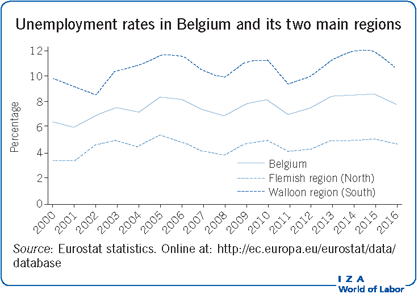Elevator pitch
Might the Belgian labor market be included in the gallery of “Belgian surrealism”? At first sight, Belgium with its 11 million inhabitants has withstood the Great Recession and the euro area debt crisis relatively well, quickly getting back on track toward growth and employment, apparently without rising earnings inequality. But if one digs a little deeper, Belgium appears to be a strongly segmented labor market, first and foremost in an astounding north–south regional (linguistic) dimension. This extreme heterogeneity, along with several demographic challenges, should serve as a warning for the future.

Key findings
Pros
By the end of 2016, employment was about 5% higher than its pre-Great Recession level.
The unemployment rate for women has been trending downward since 2005.
There is no clear-cut rise in earnings inequality.
The gender pay gap is shrinking.
Cons
Over the 2000–2016 period, the unemployment rate has trended upward.
The north–south unemployment rate gap remains huge.
Youth unemployment is far above the adult average, in particular for the low-skilled and foreign-born.
In 2016, the labor force participation rate remained well below the EU15 average, especially for people aged 55 and over.
Real earnings have hardly increased since 2000, and the incidence of poverty among the unemployed has risen in the last decade.